Related Research Articles

Bristol city centre is the commercial, cultural and business centre of Bristol, England. It is the area north of the New Cut of the River Avon, bounded by Clifton Wood and Clifton to the north-west, Kingsdown and Cotham to the north, and St Pauls, Lawrence Hill and St Phillip's Marsh to the east. The Bristol Royal Infirmary, Bristol Royal Hospital for Children, the BBC, the main campus of the University of Bristol, the Crown and Magistrate's Courts, Temple Meads railway station, Bristol bus station, the Park Street, Broadmead and Cabot Circus shopping areas together with numerous music venues, theatres and restaurants are located in this area. The area consists of the council wards of Central, Hotwells & Harbourside, and part of Lawrence Hill.
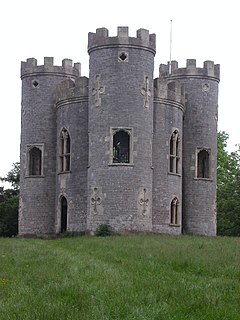
Blaise Castle is a folly built in 1766 near Henbury in Bristol, England. The castle sits within the Blaise Castle Estate, which also includes Blaise Castle House, a Grade II* listed 18th-century mansion house. The folly castle is also Grade II* listed and ancillary buildings including the orangery and dairy also have listings. Along with Blaise Hamlet, a group of nine small cottages around a green built in 1811 for retired employees, and various subsidiary buildings, the parkland is listed Grade II* on the Register of Historic Parks and Gardens of special historic interest in England.
Thomas Paty was a British surveyor, architect and mason working mainly in Bristol. He worked with his sons John Paty and William Paty.
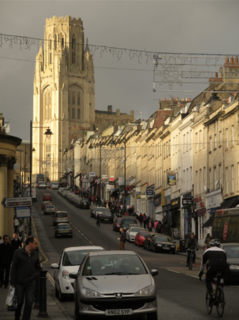
Park Street is a major shopping street in Bristol, England, linking the city centre to Clifton. It forms part of the A4018.
George Tully was a carpenter and surveyor in Bristol, England.

Bristol Central Library is a historic building on the south side of College Green, Bristol, England. It contains the main collections of Bristol's public library.

St Mark's Church is an ancient church on the north-east side of College Green, Bristol, England, built c. 1230. Better known to mediaeval and Tudor historians as the Gaunt's Chapel, it has also been known within Bristol since 1722 as the Lord Mayor's Chapel. It is one of only two churches in England privately owned and used for worship by a city corporation. The other is St Lawrence Jewry, London. It stands opposite St Augustine's Abbey, founded by a member of the Berkeley family of nearby Berkeley Castle, from which it was originally separated by the Abbey's burial ground, now called College Green. It was built as the chapel to the adjacent Gaunt's Hospital, now demolished, founded in 1220. Except for the west front, the church has been enclosed by later adjacent buildings, although the tower is still visible. The church contains some fine late gothic features and a collection of continental stained glass. It is designated by Historic England as a grade I listed building.

The Great Gatehouse, also known as the Abbey Gatehouse, is a historic building on the south side of College Green in Bristol, England. Its earliest parts date back to around 1170. It was the gatehouse for St Augustine's Abbey, which was the precursor of Bristol Cathedral. The gatehouse stands to the cathedral's west, and to its own west it is abutted by the Bristol Central Library building. The library's architectural design incorporated many of the gatehouse's features.
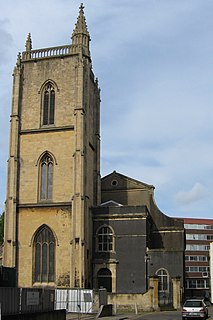
St Thomas the Martyr is a former Church of England parish church on St Thomas Street in the Redcliffe district of the English port city of Bristol.
William Venn Gough (1842–1918) was an architect responsible for a number of prominent buildings in Bristol. His works include the Cabot Tower, Colston's Girls' School, Trinity Road Library, St Aldhelm's church and South Street School in Bedminster, the village hall in Yatton, and Port of Bristol Authority Docks Office, now Queen Square House, in Queen Square.
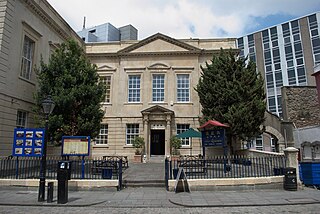
The Old Library is a historic building on the north side of King Street, Bristol, England. It was built in 1738–40 and has been designated by English Heritage as a grade II* listed building.
James Paty the Younger (1718–1779) was an English mason, builder and architect. He was a member of the Paty family which was prominent in the building of 18th century Bristol. He was the partner of his brother Thomas Paty in some of his building developments. He is also thought to have been the site architect during the rebuilding of Stoke Park House at Stoke Gifford.
George Weare Braikenridge (1775–1856) was an English antiquarian. He was born in the Colony of Virginia, but lived for most of his life in Bristol, England, where he created a large collection of Bristolian historical and topographical material known as the Braikenridge Collection. It contains over 1400 drawings and watercolours of Bristol landscapes and buildings. These are held in Bristol City Museum and Art Gallery, with related collections of manuscripts and other items held by Bristol Central Library and Bristol Archives. The Braikenridge Collection has become the most important historical record of Bristol's appearance in the early 19th century, and makes Bristol one of the best documented English cities in this respect.
Hugh O'Neill (1784–1824) was an English architectural and antiquarian draughtsman who contributed 441 drawings of scenes from Bristol, England to the topographical collection of George Weare Braikenridge. The Braikenridge Collection makes Bristol's early 19th century appearance one of the best documented of any English city.
Thomas Leeson Scrase Rowbotham (1782–1853) was an English watercolourist and oil painter. He was a skilled painter of landscapes and marine subjects, became professor of drawing at the Royal Naval School and produced books on painting and drawing. He contributed 258 watercolours of scenes from Bristol, England to the topographical collection of George Weare Braikenridge. The Braikenridge Collection makes Bristol's early 19th century appearance one of the best documented of any English city.

Samuel Jackson was an English watercolourist and oil painter who has been called the "father" of the Bristol School of artists. He also contributed a number of drawings of scenes from Bristol, England to the topographical collection of George Weare Braikenridge. The Braikenridge Collection makes Bristol's early 19th century appearance one of the best documented of any English city.
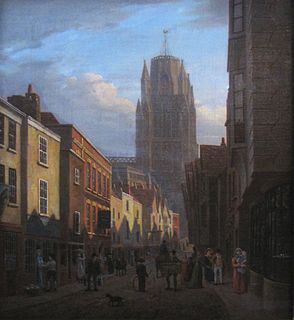
James Johnson (1803–34) was an English architectural draughtsman, watercolourist and oil painter who was a member of the Bristol School of artists. He contributed nearly 50 drawings of scenes from Bristol, England to the topographical collection of George Weare Braikenridge. The Braikenridge Collection makes Bristol's early 19th century appearance one of the best documented of any English city. Johnson was also a painter of poetic landscapes in oil.
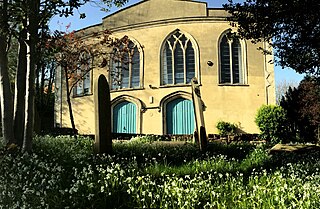
Hope Chapel is home to Hope Community Church in Hotwells, Bristol, England. It is a Grade II listed building.
Ashton Gate Brewery Co Ltd was a brewing company based in Bristol, UK. It was one of the first 1000 companies registered in England and Wales.

Temple Quay is an area of mixed-use development in central Bristol, England. The project was initiated by Bristol Development Corporation in 1989, under the name Quay Point until 1995. In that year it was handed over to English Partnerships, under whom development eventually started in 1998. It is bounded by Temple Way to the west and Bristol Temple Meads railway station to the southeast; to the northeast the development was bounded by Bristol Floating Harbour until 2002, when development of Temple Quay North started on the harbour's other side. In 2012 the whole area became part of Bristol Temple Quarter Enterprise Zone.
References
- ↑ Annals of Bristol [17th to 19th Century]. W. George's sons, W. & F. Morgan. 1893. pp. 227–.
- ↑ John Corry; John Evans (1816). The History of Bristol, Civil and Ecclesiastical. W. Sheppard. pp. 155–.
- ↑ Andrew Foyle (2004). Bristol . Yale University Press. pp. 189–. ISBN 978-0-300-10442-4.
- ↑ George Bryce (1861). A Popular History of Bristol: Antiquarian, Topographical and Descriptive from the Earliest Period to the Present Time ; with Biographical Notices of Eminent Natives and Residents, Impartially Written. W. Mack. pp. 167–.
- Andrew Foyle, 'Pevsner Architectural Guides: Bristol', Yale University Press (2004) ISBN 0-300-10442-1
- Walter Ison, The Georgian Buildings of Bristol, Kingsmead Press (1978) ISBN 0-901571-88-1
Coordinates: 51°27′13″N2°36′10″W / 51.45349°N 2.60282°W
| This Bristol location article is a stub. You can help Wikipedia by expanding it. |